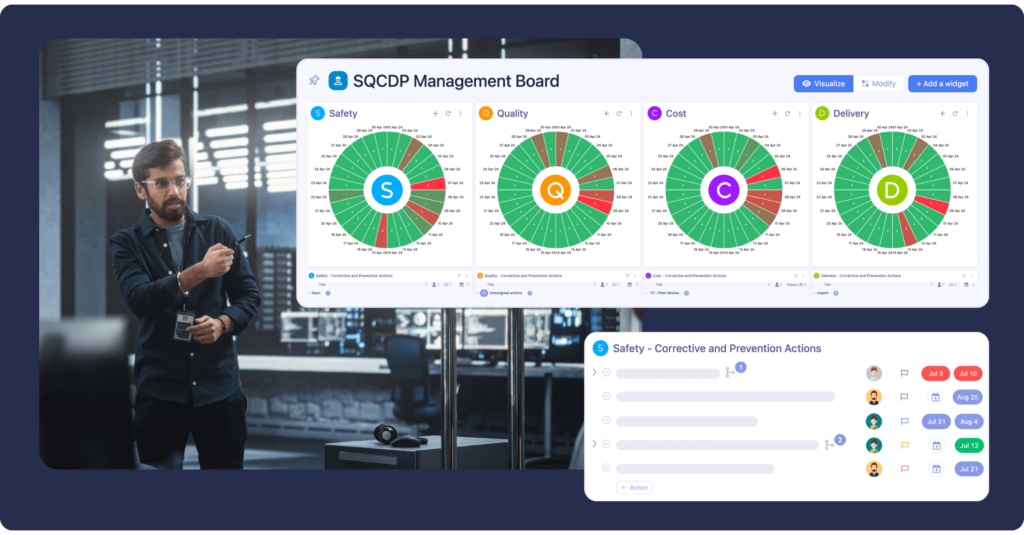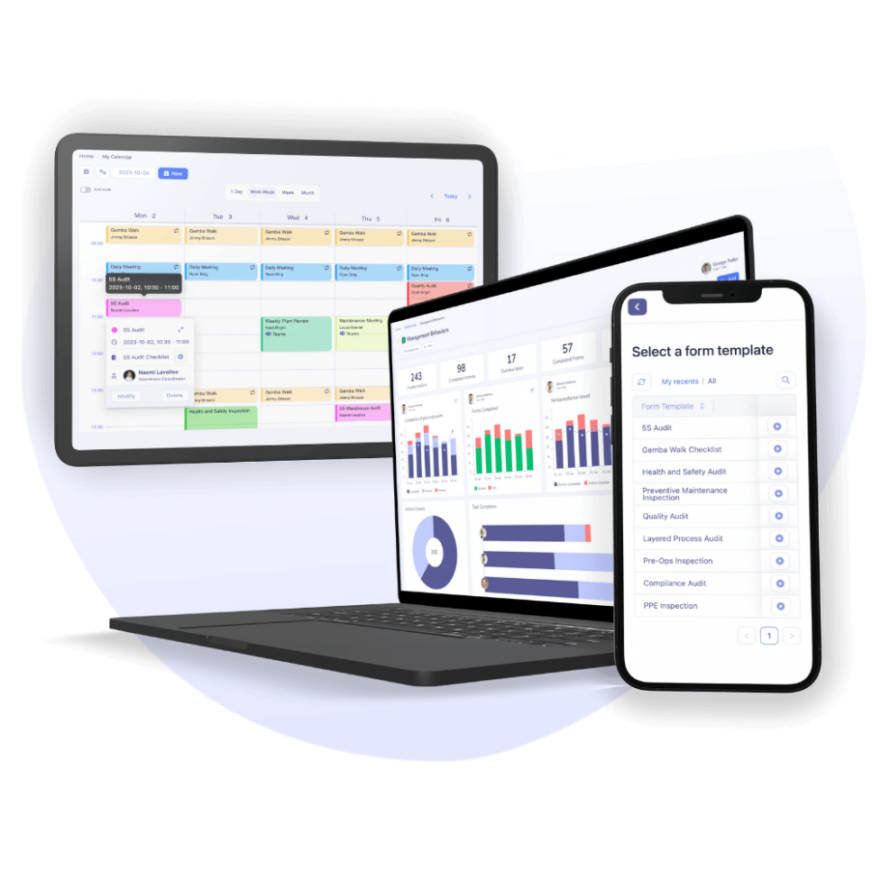How Gemba Boards Unlock Shop Floor Potential

| Audience: | Manufacturing Managers, Healthcare Administrators, Operational Excellence and Lean Management Practitioners, HR Coordinators, Organizational Leaders |
| Last updated: | August 27, 2025 |
| Read time: | 4 min |
- Visualize key metrics like safety, quality, and productivity in real time
- Empower teams to act faster with clear insights and structured daily routines
- Support continuous improvement through better engagement and decision-making
Why use a Gemba Board in manufacturing?
In modern manufacturing, operational control begins on the shop floor—not behind a desk. It’s forged right where the action happens. That’s where the Gemba board comes in, as a valuable tool for managers and supervisors to maintain oversight and control over critical domains like safety, quality, and productivity. By presenting information visually, it supports quick comprehension and data-driven decision-making.
What is a Gemba Board? Gemba Board meaning
A Gemba board is a visual management tool designed to support clear thinking, track the current status of processes, and identify deviations from standard procedures in real time. ‘Gemba’ is a Japanese term meaning ‘the actual place’. In the context of lean manufacturing, it refers to the shop floor—the location where value is created.

Example of a Gemba Board: the SQDIP format
In lean manufacturing scenarios, Gemba boards often use columns for key performance categories, rather than workflow stages:
- Safety: Tracks incidents, near misses, or other conditions affecting safety
- Quality: Monitors defects, rework, and adherence to quality standards
- Delivery: Measures performance against production schedules or takt time
- Inventory: Assesses stock levels, material availability, or flow efficiency
- Productivity: Captures output efficiency, downtime, and resource utilization
The five-column SQDIP format depicted above is one of the most common. Its main purpose is to quantify performance and make it visible to facilitate communication and decision-making at the point of activity. Unlike other management boards located in back offices, these boards support operational excellence by empowering teams to act where value is created.
How SQDIP compares to SQCDP and SQDCM
By contrast, other visual management tools have a different focus. For example, an SQCDP (Safety, Quality, Cost, Delivery, People) board, while superficially similar, offers a structured overview of broader business KPIs. Meanwhile, a SQDIP (Safety, Quality, Delivery, Inventory, Productivity) Gemba board zeroes in on immediate operational conditions and drives shop-floor action through direct observation—such as those captured during Gemba walks or Kaizen events.
| Features | SQCDP | SQDCM |
|---|---|---|
| Location | On the shop floor | Office or meeting room |
| Primary purpose | Drive immediate action | Track strategic KPIs |
| Interaction style | Frontline engagement | Periodic reviews and updates |
| Common use cases | Gemba walks, daily huddles | Management dashboards |
Industry leaders leverage Tervene to gain visibility

How to make a Gemba Board (Gemba Board template)
A well-designed Gemba board provides clarity and drives action. While customization based on the specific use case is essential, all boards should include some universal components to ensure effectiveness:
- Key performance indicators (KPIs): These real-time or near real-time insights reflect the health of a specific process, such as hourly production targets, defect counts, or equipment uptime.
- Action item tracking: Provide a clear log of task assignments and observations from Gemba walks or daily huddles.
- Problem-solving areas: Highlight root causes using structured methods like the 5 Whys to identify the cause of an issue.
The above data points may be color-coded to communicate status or importance. For example, a KPI in red may require corrective actions.

Explore 10 Visual Management Must-Haves [eBook]
Physical vs. virtual Gemba Boards
Gemba boards don’t operate in isolation. They support teams and should be placed in a central location on the shop floor. However, digital Gemba boards allow for seamless integration with enterprise resource planning (ERP) systems, helping unify data sources like MES or quality management tools.
By ensuring date data is always up to date, digital boards help teams access accurate, real-time information to act on.
Gain clear visibility and track KPIs with Tervene’s tools
Gemba Walk Boards: supporting Leader Standard Work
The strength of a Gemba board lies in how it’s used during routine management practices like Gemba walks. These walks allow managers to understand the context, gather employee feedback, and make targeted adjustments. Boards serve as a record of the first step toward improvement and align with the principles of Leader Standard Work.
Key Gemba Board metrics to track
To make the most of a Gemba board, choose metrics that reflect performance and support goals. Common examples include:
- Hourly or daily production output
- Quality defects or scrap rate
- Equipment downtime
- Safety incidents or near misses
- Inventory levels and material flow
Gemba Board ideas and supplies
Ideas
- Add a “win of the day” section to boost morale
- Display improvement suggestions or targets visually
- Let teams personalize a section to increase sense of ownership
Supplies
- Whiteboard, magnetic board, or digital screen
- Visual symbols, dry-erase markers, printed templates
- Sticky notes, task cards, or tablets for digital input
Gemba Board meetings: structure and frequency
Effective use of Gemba boards involves structured interactions:
- Daily huddles: Focus on information flow and KPI review
- Tiered meetings: Escalate unresolved blockers
- Gemba walks: Record and act on team input, improving transparency
Lean Visual Management with Gemba Boards
Gemba boards are a foundational lean visual management tool that support continuous improvement. Whether physical or digital, they help visualize goals, encourage open communication, and keep everyone focused on value creation.

Gain visibility with Tervene's Gemba Board tools
Tervene helps teams unlock the value of Gemba boards. Ready to get started? Explore how our digital tools integrate boards into your daily operations and management system.
Gain visibility with Tervene’s visual management system
Explore Tervene’s visual management toolsFAQ: Gemba Boards
A Gemba board is used to visualize key operational data on the shop floor. It helps teams track performance, identify problems, and support daily decision-making through real-time information and structured routines like Gemba walks.
“Gemba” is a Japanese term meaning “the actual place.” In Lean, it refers to the location where value is created—typically the shop floor—emphasizing direct observation as a way to understand processes and drive improvement.
Most Gemba boards include:
-
Key performance indicators (KPIs)
-
Action item tracking
-
Problem-solving areas (e.g. root cause analysis)
-
Visual status indicators (e.g. color-coded symbols)
SQDIP stands for Safety, Quality, Delivery, Inventory, and Productivity. It’s a five-column format commonly used on Gemba boards to monitor performance in these critical areas and enable quick, frontline decision-making.
-
SQDIP: Focused on real-time shop floor activity and immediate corrective action.
-
SQCDP: Broader, strategic view with added focus on Cost and People.
-
SQDCM: Often used in healthcare or morale-focused environments, replacing Productivity with Morale.
No. Gemba boards can be physical or digital. Digital Gemba boards integrate with tools like ERP, MES, or quality systems to provide centralized, real-time visibility—ideal for multi-site operations and remote collaboration.
Daily. Gemba boards are typically reviewed during daily huddles, Gemba walks, or tiered meetings. Frequent interaction ensures problems are surfaced quickly and improvement actions are tracked.
Absolutely. By making problems and progress visible, Gemba boards enable teams to act quickly, reinforce standard work, and drive continuous improvement through ownership and accountability.
-
Include a “win of the day” or improvement spotlight
-
Let team members personalize sections
-
Use symbols and visual indicators to improve clarity and ownership
Ideally, in a central location on the shop floor where it’s accessible to frontline teams. Digital versions should be hosted on platforms visible to both operations and leadership.

























